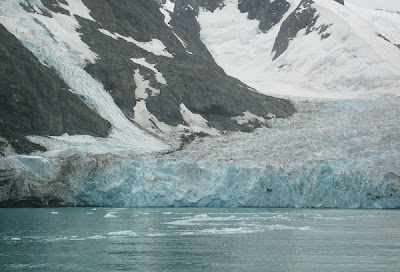The vast majority of expedition cruises to Antarctica go from South America to the Antarctic Peninsula, and the map shows why. South America extends much farther south than Africa or Australia, and the Antarctic Peninsula is the northernmost point of the white continent, so the crossing is feasible for many kinds of ships. There are also some expedition cruises that go south from New Zealand and take in the subantarctic islands of that country, and a few cruises that go south through the bird-rich waters of South Africa to the continent's edge, and we would like to try those routes eventually. But so far, all five of my trips have originated in South America.
Most world maps (like the one above) show Antarctica as an ill-defined mass along the lower edge, so it's hard for most people to get an idea of the continent's size. Antarctica is huge -- near the size of Australia and Europe combined. It is roughly centered on the South Pole, and the interior of the continent is the coldest region on earth. We confess that, as naturalists, we're not very interested in visiting the South Pole; nothing lives there except a few dedicated scientists. Remarkably, the South Polar Skua has occurred there as a stray, having flown many hundreds of miles across lifeless ice and rock, but we'd rather watch birds like this out at the Antarctic coastline where they belong.







 BEWARE!
BEWARE! 















 Here’s a new kind of bird identification quiz. The picture here is a kind of digital jigsaw puzzle with most of the pieces removed. Can you tell, from the pieces visible here, what kind of bird this is? (If you can, you’re some kind of super-birder!)
Here’s a new kind of bird identification quiz. The picture here is a kind of digital jigsaw puzzle with most of the pieces removed. Can you tell, from the pieces visible here, what kind of bird this is? (If you can, you’re some kind of super-birder!)
 The mother tiger after recovering from the delivery, suddenly started to decline in health, although physically she was fine. The veterinarians felt that the loss of her litter had caused the tigress to fall into a depression. The doctors decided that if the tigress could surrogate another mother's cubs, perhaps she would improve.
The mother tiger after recovering from the delivery, suddenly started to decline in health, although physically she was fine. The veterinarians felt that the loss of her litter had caused the tigress to fall into a depression. The doctors decided that if the tigress could surrogate another mother's cubs, perhaps she would improve. After checking with many other zoos across the country, the depressing news was that there were no tiger cubs of the right age to introduce to the mourning mother. The veterinarians decided to try something that had never been tried in a zoo environment. Sometimes a mother of one species will take on the care of a different species. The only orphans' that could be found quickly were a litter of weanling pigs. The zoo keepers and vets wrapped the piglets in tiger skin and placed the babies around the mother tiger. Would they become cubs or pork chops?
After checking with many other zoos across the country, the depressing news was that there were no tiger cubs of the right age to introduce to the mourning mother. The veterinarians decided to try something that had never been tried in a zoo environment. Sometimes a mother of one species will take on the care of a different species. The only orphans' that could be found quickly were a litter of weanling pigs. The zoo keepers and vets wrapped the piglets in tiger skin and placed the babies around the mother tiger. Would they become cubs or pork chops? Now, please tell me one more time... Why can't the rest of the world get along?
Now, please tell me one more time... Why can't the rest of the world get along? 'Life isn't about waiting for the storm to pass; it's about learning to dance in the rain.'
'Life isn't about waiting for the storm to pass; it's about learning to dance in the rain.'

 Gazelles, buffalo, eland, wildebeest and zebra roam the very same savannah as their large carnivore neighbours.
Gazelles, buffalo, eland, wildebeest and zebra roam the very same savannah as their large carnivore neighbours. Three young males, possibly brothers, were spotted on a hillside.
Three young males, possibly brothers, were spotted on a hillside. Hearing the crackle of twigs, Samson killed the noisy ignition. Rustling through the grass was a lone bull elephant.
Hearing the crackle of twigs, Samson killed the noisy ignition. Rustling through the grass was a lone bull elephant.

.jpg)















